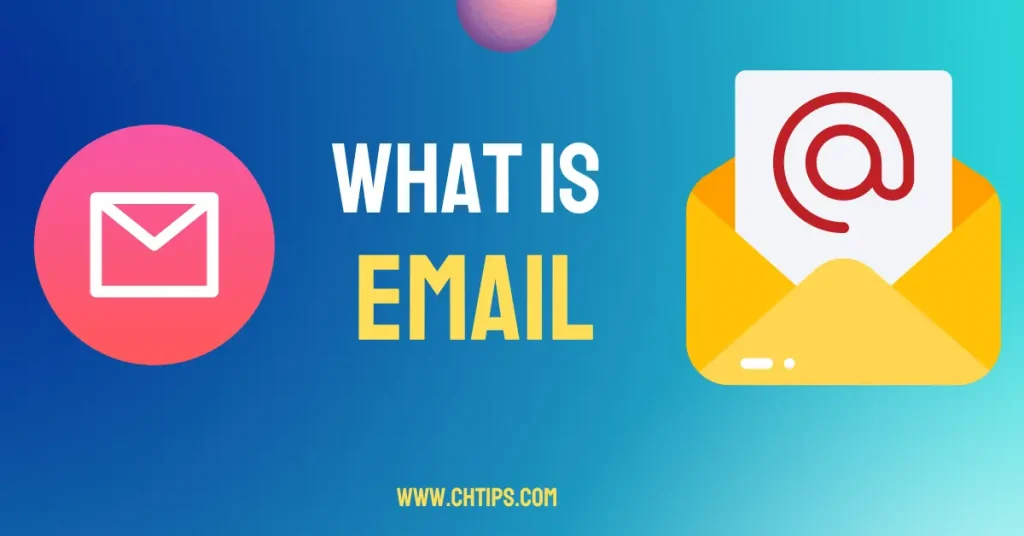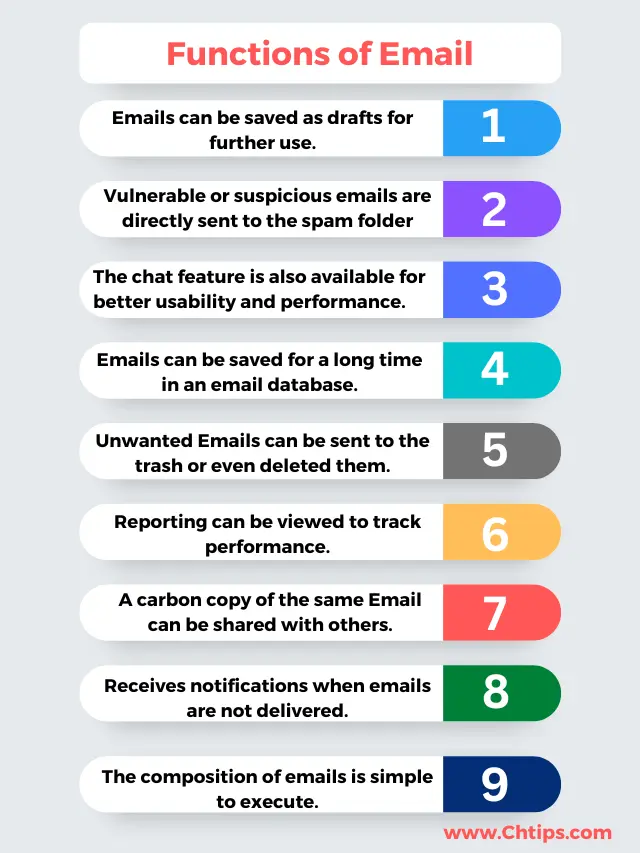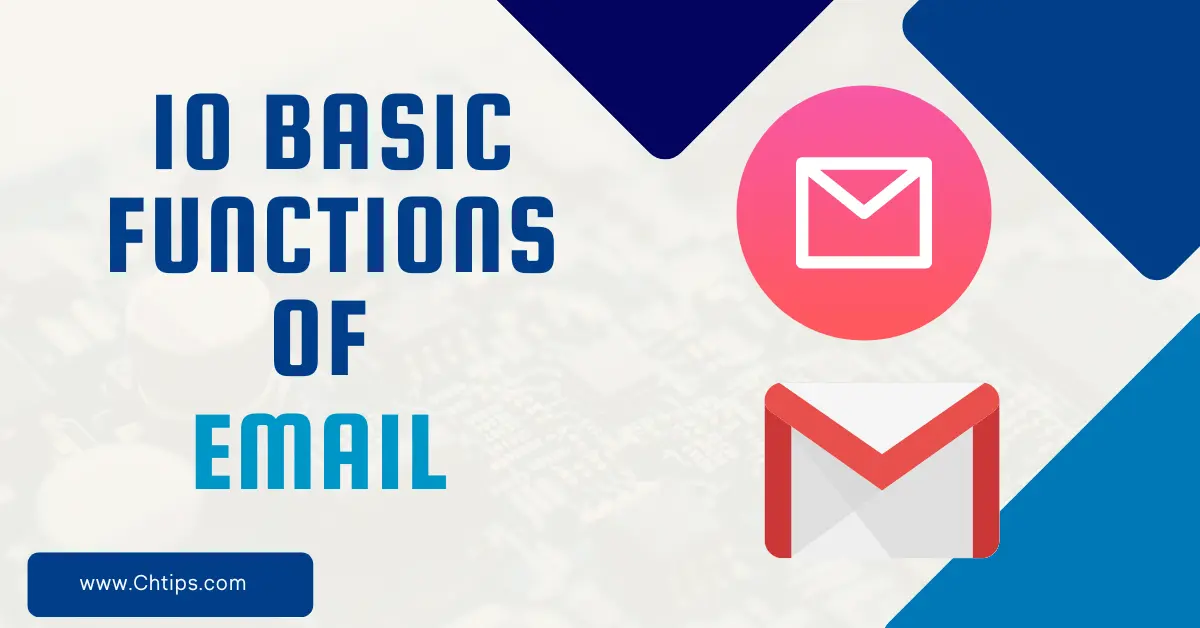The Email was invented by an American programmer named Raymond Samuel Tomlinson in 1971.
The email has easily replaced old means of communication.
The functions of Email and uses of Email have revolutionized the communication industry.
There are several advantages and disadvantages of using an email system.
Email can be accessed using mobile phones with an internet connection.
Most email services are free; some famous companies that provide such services are Gmail, Yahoo Mail, etc.
What is Email With Example?
Email stands for electronic mail, also referred to as mail.
Email is a digital message transferred from one computer to another to help in better communication.
Email is considered the fastest, most reliable, and cheapest communication method between users and users.

The Email can instantly attach text, images, videos, PPTs, and slides to itself and forward them to others.
The Email can be sent to a different individual, or bulk messages can be performed with just one click using a feature like BCC.
Email can be accessed with the help of a computer, laptop, tablet, or mobile phone with an internet connection. Email cannot be accessed if the internet is missing.
An email has easily replaced old fashion letters due to its instant result and 100% accuracy.
10 Functions of Email
- Automatic reply and forwarding of emails.
- Autoresponder can be used while accepting and sending bulk emails.
- The extensive contact list can be saved and further used to save time.
- A large number of emails can be sent instantly.
- The composition of emails is simple to execute.
- Receives notifications when emails are not delivered.
- A carbon copy of the same Email can be shared with others.
- Reporting can be viewed to track performance.
- Unwanted Emails can be sent to the trash or even deleted them.
- Emails can be saved for a long time in an email database.
- Emails can be saved as drafts for further use.
- Vulnerable or suspicious emails are directly sent to the spam folder
- The chat feature is also available for better usability and performance.
Learn Functions of Email With Picture

7 Functions of Email Software
- Email software is extensively used to send predefined Emails to many recipients.
- They are also used to track the delivery of Emails the software has sent.
- Sending and receiving emails from your clients or customers.
- It helps to organize your emails into folders to access them easily.
- The software also calculates the number of successful delivery of Emails, with complete reports.
- Managing your inbox effectively with filters and labels so you don’t miss important messages or conversations
- They also provide an autoresponder service for any query the owner has received.
- The Email provided to such software are stored in the database permanently.
- Periodic or email scheduler can also be done using their services.
- Mail Chimp is a company that offers such services.
4 Types of Email
- Promotional Emails.
- Survey Emails.
- Newsletter Emails.
- Professional Email
Five Features of Emails
5 significant features of emails are included below.
- Easy to Use.
- Efficient.
- Personalized Emails.
- Fast in Processing.
- Used Anywhere.
#1. Easy To Use.
Email systems are elementary to use and implement. It can be used with the help and assistance of mobile phones, laptops, and desktop computers with an internet connection.
Email Systems are designed and developed according to the user’s needs; hence, continuous efforts have made them more user-friendly than ever before.
Using mobile phones, users can directly access emails and messages in the mobile phones’ memory and inbox.
#2. Efficient.
Email is one of the most convenient modes of communication. Once sent, the email can reach its destination within a few seconds.
Email is an efficient way of communication.
Communication made between two ends using emails is the fastest communication mode.
Email is easy to send and receive, making it the most famous form of electronic communication. Responding from anywhere worldwide is also possible, making it very convenient.
#3. Personalized.
Email is one of the essential tools used in business and personal stuff. Email communication is made simple to use and handle.
Personalized emails can include images, social media icons, and a signature at the bottom of every email.
#4. Fast in Processing.
Speed is an essential feature of emails.
The email can be sent from anywhere using laptops, computers, and mobile phones with the help of an internet connection.
#5. Used Anywhere.
Email can be used anywhere. It has no restrictions.
The basic setup required to use emails is an internet connection and devices to use the internet.
15 Uses of Email in Daily Life
The email is an integral part of modern communication system that is used and utilized for sharing data and information.
There are various significant uses of email in daily life that are mentioned and included.
| 1 | Communication with Family and Friends. |
| 2 | Education. |
| 3 | Newsletter. |
| 4 | Banking and Financial Transactions. |
| 5 | Document Sharing. |
| 6 | Submitting Resume. |
| 7 | Digital Signatures. |
| 8 | Communication With Secrecy. |
| 9 | Customer Support. |
| 10 | Business Communication. |
10 Uses of Email in Education
Emails are significantly used and utilized in education sector that are used in effective communication between students and instructors.
- Simple and Easy Communication Between Instructor and Students.
- Sharing Data and Information.
- Reminders and Announcement.
- Distance Learning.
- Submitting Homework and Assignment.
- Group Discussion.
- Forwarding Bulk SMS can Save Time.
- Receiving Feedbacks.
- Personal Touch.
- Sharing Financial Programs.
- Progress Report and Analysis.
Full Form of Email
Email Stands for Electronic Mail.
Who is the Father of Email?
Raymond Samuel Tomlinson
Useful Video On: How Email Works?
4 Essential Parts of Email
- Recipients [To]
- CC
- BCC
- Message Body
Basic Format of Email
The email services can be web-based or mobile-based applications
| To | Recipient Email Address. |
| FROM | Sender Email Address |
| Date | Date of Email. |
| Subject | A single line of text. |
| CC | Sending carbon copy to another person except for the original recipient. |
| BCC | Used to send Emails to a large number of people. |
Top Email Service Provider and Launched Date
| # | Company | Launched Date |
| 1 | Gmail | April 1, 2004 |
| 2 | Yahoo Mail | October 8, 1997 |
| 3 | Rediffmail | February 8, 1996 |
| 4 | Rocket Mail | June 19, 2008 |
| 5 | Proton Mail | May 16, 2014 |
| 6 | Titan | 2018 |
| 7 | Zoho Mail | March 2006 |
| 8 | Outlook | July 4, 1996 |
Example of Email

10 Uses of Email
- Emails are reliable sources of communication globally. Therefore used and utilized worldwide.
- It respects privacy, as users can respond when an email is received at their convenience.
- Files, documents, and the digital doc can be shared with others.
- It can also be used as proof of communication or discussion if needed.
- It is extensively used in business.
- They are also used in the education sector for proper communication and spreading messages about upcoming events, notices, etc.
- They are also used in receiving coupon codes and discounts code.
- Exam results and exam application forms can be sent via Email.
- Online complaints and suggestions can be made with the help of emails.
- They are a convenient communication source and can be used with the convenience of time and place.
6 Uses of Email in Education
- All studies-related news can be circulated via Email in bulk.
- Exam results and data can be distributed with the help of email services.
- Communication is made simple, with no time for staff members and students.
- Extra-curricular activities and their notification can be circulated in no time.
- Sending notes, files, documents, letters, and data can be done in no time.
- Emails are sent with an almost 100% success ratio and hence used and utilized in the education sector.
5 Advantages of Email
- They are the fastest, simplest, and easiest way of communication.
- Instant replies can be received using the email system.
- They are the cheapest way of communication.
- We can be in touch with anyone around the globe instantly.
- It is a paperless mode of communication.
5 Disadvantages of Email
- Your computer, laptop, or mobile device should have an internet connection to send emails. That is a significant dependency on the internet.
- The restriction on the attached file size is 25 MB on the lower side.
- Lots of unwanted Emails [promotional emails].
- Anyone can send an Email to anyone until and unless they have the email id.
- The authenticity of someone cannot be verified while communicating.
6 Importance of Email
- Emails are a faster and safer way of communication, it reduces time, with almost no security issues.
- The contact list can be saved and used whenever needed.
- Multiple emails can be sent with CC [Carbon Copy].
- Email can be sent from desktops, tablets, and mobile phones.
- The emails are sent instantly.
- Business discussions are made simple by using emails.
10 Features of Email
- Email services are used and utilized in sending and receiving messages.
- The Email ID used is unique, and creating a duplicate email ID is impossible in any mail service.
- One can use numbers, digits, and special symbols in email IDs.
- Email forwarding can be used.
- Email can be used as drafts.
- Multiple accounts can be created.
- Users have the privilege to switch accounts.
- Notification is one of the key features used in Email.
- Email can be achieved.
- Can mute information of personal accounts.
Uses of Email in Daily Life
There are various benefits and advantages of uses of email in daily life.
| # | Uses of Email |
| 1 | It helps in better personal communication. |
| 2 | It is one of the fastest ways of communication. |
| 3 | Important messages can be easily sent to loved ones across long distances, even continents. |
| 4 | It helps in sharing educational content with a group of students. |
| 5 | Important messages can be easily sent to loved ones across long distances even across continents. |
| 6 | The messages are sent without much delay. |
| 7 | It saves precious time. |
| 8 | We can get access to updated news and information. |
Security Features of Email.
Email is considered one of the most used modes of communication globally.
It is also one of the most vulnerable channels, as it’s simple for others to send unwanted messages and unwanted.
The majority of Email software can bombard emails for the promotions of products or services.
A phishing attack can be accomplished using email, tricking a user into clicking the link.
After clicking on the link, they steal your sensitive information which can be later misused.
Here I will present some tips on protecting yourself from security threats and some significant email features.
- Encryption is one of the security features of an email that encrypts your messages so that your private messages can not be edited or tempted.
- Email offers and ensures complete confidentiality for both sides of communication and prevents stealing your sensitive information.
- End-to-end encryption ensures that only those who know the secret password can read an encrypted message once it has been sent from end A to end B.
- The username and password are encrypted with the help of modern technology with a 256-bit encryption method.
- To avoid unwanted access, two-factor authentication can be used.
- Brutal Forces attacks can be restricted.
Functions of Email & Uses of Email PDF Download
People Are Also Reading
- Aerospace Engineering Vs Computer Science
- Differences Between Microsoft Bing and Microsoft Edge
- 5 Functions of Control Unit in Computer
- 10 Umbrella Activities in Software Engineering
- Different Types of Icons in Computer
- 5 Different Types of URLs
- Benefits and Drawbacks of GUI
- What are the Functions of BIOS in Computer
- What is Napier’s Bones in Computer
- Fourth Generation of Computers
- 11 Similarities Between Hardware and Software
- Processing Devices of Computer
- 5 Functions of Software in Computer
- Learn Computer Fundamentals
- Computer Basic Tutorials
Frequently Asked Questions [FAQs] on Email Functions
What are CC and BCC in Emails?
CC stands for Carbon Copy, and BCC stands for Blind Carbon Copy.
When Should BCC be Used?
BCC should be used when Email is needed to be sent to many people.
When Should CC be Used?
CC fields ask permission from the sender to send a carbon copy.
What are the Three Parts of Email?
Header, Body, and Envelope.
Why is Email so Popular?
Email has immensely improved the way of communication; also, it is an efficient and reliable means of communication; also, it saves time and resources.
What is the End of the Email Called?
An Email Signature is called the end of an Email.
Why is Email so Powerful?
Emails are a very reliable means of communication and can send messages at one time from one location to another.
First Use of Email?
The first email was sent by computer engineer Ray Tomlinson in 1971
Where was Email First Used?
The Massachusetts Institute of Technology (MIT) used the first email.
Who Uses Emails the Most?
A recent survey found that Americans use email more than anyone else.
No 1 Email Service Provider
Google Product GMAIL.
Who Created the Symbol for Email?
Raymond Tomlinson
Get In Touch
I have also written and compiled some articles on computers and telecommunications, and please go through them.
I hope you will like reading it.
I hope all the questions and queries related to 10+ Basic Functions of Email | Uses of Email | Features, Advantages & Disadvantages have been answered here.
Don’t hesitate to contact me, and if you need to add, remove or update anything from the article, please let me know in the comment section or via Email.
I will be more than happy to update the article. I am always ready to correct myself.
I was hoping you could share this article with your friends and colleagues; this motivates me to write more on related topics.
!!! Thank You For Reading !!! GOD BLESS
